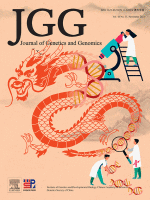2021, 48(11): 955-960.
doi: 10.1016/j.jgg.2021.06.011
Abstract:
The nucleolus, as the ‘nucleus of the nucleus’, is a prominent subcellular organelle in a eukaryocyte. The nucleolus serves as the centre for ribosome biogenesis, as well as an important site for cell-cycle regulation, cellular senescence, and stress response. The protein composition of the nucleolus changes dynamically through protein turnover to meet the needs of cellular activities or stress responses. Recent studies have identified a nucleolus-localized protein degradation pathway in zebrafish and humans, namely the Def-CAPN3 pathway, which is essential to ribosome production and cell-cycle progression, by controlling the turnover of multiple substrates (e.g., ribosomal small-subunit[SSU] processome component Mpp10, transcription factor p53, check-point proteins Chk1 and Wee1). This pathway relies on the Ca2+-dependent cysteine proteinase CAPN3 and is independent of the ubiquitin-mediated proteasome pathway. CAPN3 is recruited by nucleolar protein Def from cytoplasm to nucleolus, where it proteolyzes its substrates which harbor a CAPN3 recognition-motif. Def depletion leads to the exclusion of CAPN3 and accumulation of p53, Wee1, Chk1, and Mpp10 in the nucleolus that result in cell-cycle arrest and rRNA processing abnormality. Here, we summarize the discovery of the Def-CAPN3 pathway and propose its biological role in cell-cycle control and ribosome biogenesis.







